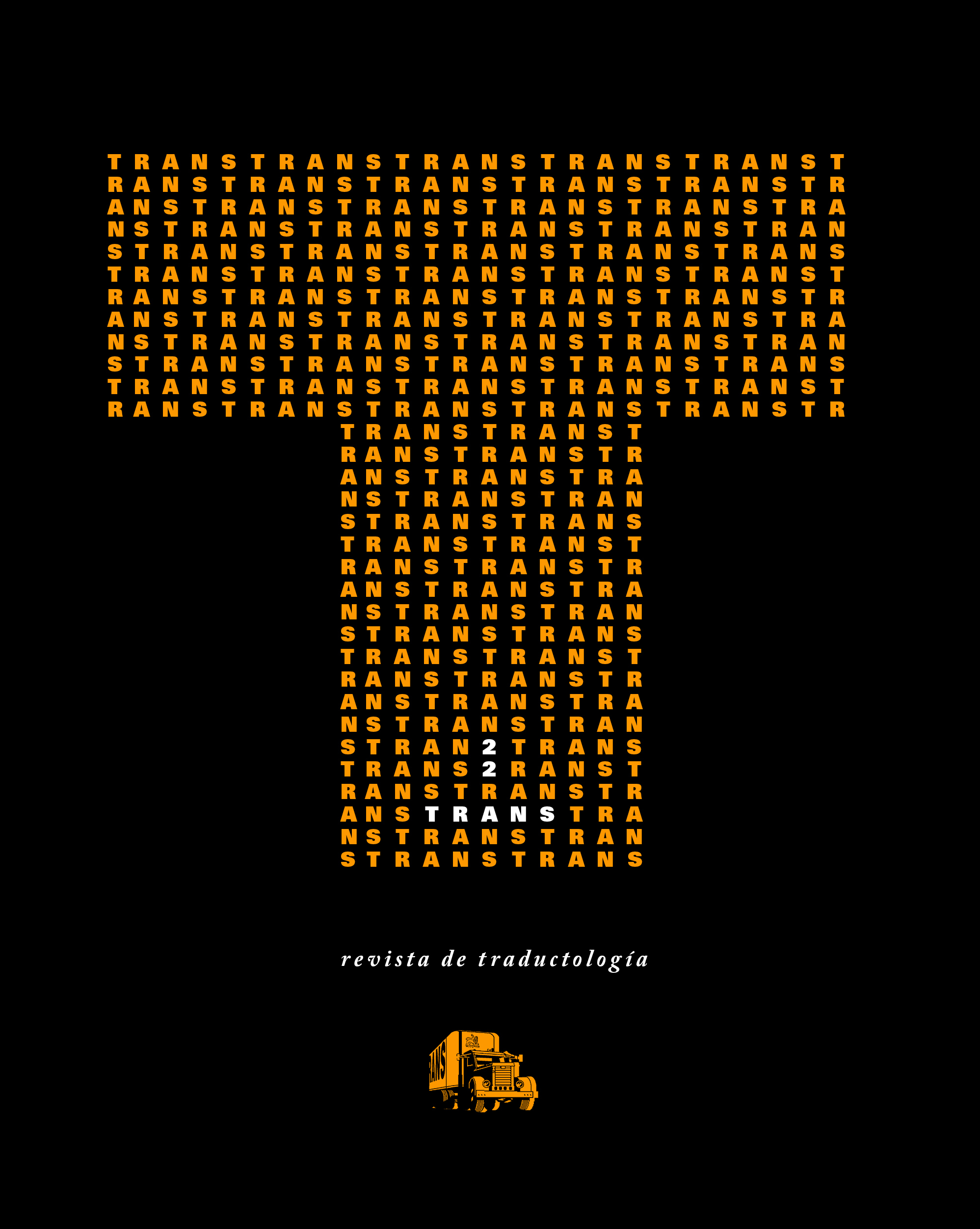Dispositio and compositio in translation of poetry Turkish-Spanish
DOI:
https://doi.org/10.24310/TRANS.2018.v0i22.4076Keywords:
Rhetoric, poetry translation, dispositio, elocutio, Turkish-Spanish translationAbstract
If we accept the conception of Rhetoric as a general discipline of discourse as held by the New Rhetoricians, we could describe translation as a rhetorical operation. This is particularly evident in the translation of poetry, being a highly systematized genre. Thus, we can make use of traditional rhetorical categories when analyzing poetry translations. We can even find translation strategy differences between categories so close in appearance as the dispositio and the compositio. As an example, we analyze the collective translation of a fragment of
a well-known poem by the Turkish author A. H. Tanp?nar.
Downloads
Metrics
Publication Facts
Reviewer profiles N/A
Author statements
Indexed in
-
—
- Academic society
- N/A
- Publisher
- Universidad de Málaga
References
Albaladejo Mayordomo, Tomás (1988-1989): «Semántica y sintaxis del texto retórico: inventio, dispositio y partes orationis», E.L.U.A. Estudios de Lingüística Universidad de Alicante, no. 5, 9-15.
Arduini, Stefano (2000): Prolegómenos a una teoría general de las figuras, Murcia: Universidad de Murcia, Servicio de Publicaciones.
Barthes, Roland (1964) : «Rhétorique de l'image», Communications, 4, 40-51.
Barthes, Roland (1970): «La retórica antigua. Prontuario», en La aventura semiológica, trad. de Ramón Alcalde, Barcelona: Paidós, 2ª edición española,1993.
Bassnett, Susan (1980): Translation Studies, 3rd edition, London: Routledge 2002.
Carpintero, Rafael (2017): «Back to Basics: Transfer as a Metaphorical Process», Litera, no. 27 (1), 1-21.
Cirlot, Juan Eduardo (1968): Diccionario de símbolos, Barcelona: Labor, 9ª ed., 1992.
Connolly, David (1998): «Poetry Translation», en Mona Baker (ed.): Routledge Encyclopedia of Translation Studies, London and New York: Routledge, 2001.
García Berrio, Antonio (1984): «Retórica como ciencia de la expresividad. Presupuestos para una retórica general», E.L.U.A. Estudios de Lingüística Universidad de Alicante, nº 2, 7-59.
García Berrio, Antonio y Tomás Albaladejo Mayordomo (1983): «Estructura composicional. Macroestructuras», E.L.U.A. Estudios de Lingüística Universidad de Alicante, nº 1, 127-180.
Grupo µ (1977) : Rhétorique de la poésie. Lecture linéaire, lecture tabulaire, Paris: Éditions du Seuil, 1990.
Grupo µ (1992): Tratado del signo visual. Para una retórica de la imagen, trad. de Manuel Talens Carmona, Madrid: Cátedra, 1993.
Grupo ? (1970): Retórica general, trad. de Juan Victorio, Barcelona: Paidós, 1987 (edición española revisada).
Hjelmslev, Louis (1943): Prolegómenos a una teoría del lenguaje, trad. de José Luis Díaz de Liaño, Madrid: Gredos, 1971.
Holmes, James S. (1970): «Forms of Verse Translation and the Translation of Verse Form», en James S. Holmes (ed.): The Nature of Translation: Essays on the Theory and Practice of Literary Translation, The Hague-Paris: Mouton.
Hurtado Albir, Amparo (2001): Traducción y traductología. Introducción a la traductología, Madrid: Cátedra.
Jakobson, Roman (1958): «Linguistics and Poetics», en Thomas A. Sebeok (ed.): Style in Language, Cambridge, Mass.: Technology Press of Massachusetts Institute of Technology; New York & London : John Wiley & Sons,1960.
Jones, Francis R. (1989): «On Aboriginal Sufferance: A Process Model of Poetic Translating», Target, vol. 1, nº 2, 183-199.
Lefevere, André (1975): Translating Poetry: Seven Strategies and a Blueprint, Amsterdam: Van Gorcum.
Lefevere, André (1992): Traducción, reescritura y la manipulación del canon literario, trad. de Mª del Carmen África Vidal y Román Álvarez, Salamanca: Colegio de España, 1997.
Lindgren, Marcia H., Life Blumberg y Joshua Langseth (2010): «From Literal to Literary: A Translation Project for Latin Poetry Classes», Teaching Classical Languages, vol. 1, nº 2, primavera, 109-137.
Morris, Charles (1938): Fundamentos de la teoría de los signos, trad. de Rafael Grasa, Barcelona: Paidós, 1985.
Torre, Esteban (2000/2014): Métrica española comparada, Sevilla: Universidad de Sevilla.
Torre, Esteban (2003): «Sílabas y acentos. Fundamentos fonéticos y fonológicos del ritmo», Rhythmica, vol. I, no. 1, pp. 273-301.
Downloads
Published
How to Cite
Issue
Section
License
All contents published in TRANS. Revista de Traductología are protected under the Creative Commons Attribution-NonCommercial-ShareAlike 4.0 International (CC BY-NC-SA 4.0) license. All about this license is available in the following link: <http://creativecommons.org/licenses/by-nc-sa/4.0>
Users can copy, use, redistribute, share and exhibit publicly as long as:
- The original source and authorship of the material are cited (Journal, Publisher and URL of the work).
- It is not used for comercial purposes.
- The existence of the license and its especifications are mentioned.
- ShareAlike — If you remix, transform, or build upon the material, you must distribute your contributions under the same license as the original.
There are two sets of authors’ rights: moral and property rights. Moral rights are perpetual prerogatives, unrenounceable, not-transferable, unalienable, imprescriptible and inembargable. According to authors’ rights legislation, TRANS. Revista de Traductología recognizes and respects authors moral rights, as well as the ownership of property rights, which will be transferred to University of Malaga in open access.
The property rights are referred to the benefits that are gained by the use or the dissemination of works. TRANS. Revista de Traductología is published in an open access form and it is exclusively licenced by any means for doing or authorising distribution, dissemination, reproduction, , adaptation, translation or arrangement of works.
Authors are responsable for obtaining the necessary permission to use copyrighted images.













21.png)
